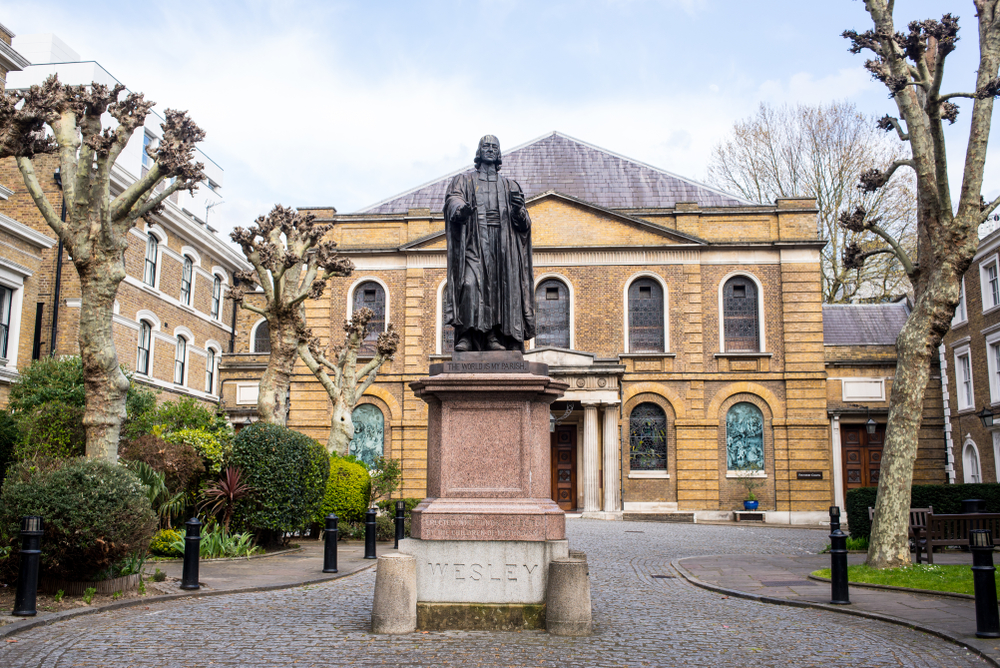In the middle decades of the 18th century, a powerful spiritual movement swept through much of North America and Great Britain, as well as some parts of northern Europe. This evangelical revival (or, in North America, the Great Awakening) transformed not only individual believers but culture and society as well, and produced some extraordinary personalities, people used mightily by God.
Over the course of 2023, I will introduce some of the key personalities of the revival in Britain. Some of the names may be known to you; others less so or not at all. However, what we will see is the way in which God transformed the heart and lives of these individuals and how they in turn changed both the church and the society of which they were part—a constant, powerful reminder of the impact our faith can have for the sake of our neighbors.
What Was the Evangelical Revival?
The “revival” is the name given to the series of events of intense religious fervor—local, regional, national, and international—that occurred in the mid-18th century. The revival, and those affected by it, displayed three particular characteristics. First, there was a recovery of personal piety. Britain had sunk into the mire rather quickly despite the accession in 1688 of a Protestant king and queen, William III and Mary II. The nation may have rejected Catholicism, but Protestantism as such seemed unable to renew the moral fabric of English society. The early adherents of revival rose early and prayed often and deeply. Piety shaped life. John Wesley, a Church of England cleric whose powerful preaching and disciplined spiritual practices would give birth to “methodism,” even gave himself a “grace rating,” by which he meant a self-assessed measurement of his discipleship and holiness. Second, there was a rejection of superficiality in faith in favor of more personal, intense, and substantive beliefs. This was accompanied by greater emphasis on self-examination and the all-pervading impact of sin. Journals were kept, books devoured, and good works discharged. Third, there was a recovery of the doctrines of the Reformation, a new Protestantism, if you like, giving weight to both salvation and a transformed life.
There were other characteristics, too; the preaching of the new birth (conversion) lay at the heart of the revival movement. All the main participants underwent this experience, mostly dramatically, but also, interestingly, at least in the formative period of the 1730s, independently of each other. Perhaps this was another sign of the divine origin of what was taking place? There was renewed emphasis on the personal experience of God and a desire to spread the gospel to all. Maybe it was old-fashioned Puritanism meeting the new pietism that formed evangelicalism. Revival itself was bound by neither geography nor social class. This message of spiritual renewal reached into the living rooms of the titled and wealthy and into the hearts of the poor—miners in the Kingswood district of Bristol in particular. Nor was the new evangelicalism constrained by denomination. In England, the revival progressed and, indeed, was opposed both within the established Church of England and outside of it, in the chapels and congregations of so-called nonconformity (Protestant Christians who broke away from the state church in the 17th century and beyond sometimes referred to as dissenters).
The revival was characterized by relatively large numbers of people having a common experience of God’s action in their heart in comparatively confined areas over a fairly short period of time. As just one example, within a few weeks of beginning to preach in the open air, the crowds of Kingswood miners listening to John Wesley and George Whitefield, the eloquent evangelist and itinerant preacher, grew from 200 to 10,000. Charles Wesley wrote “O for a Thousand Tongues to Sing” in 1739 just for these occasions; one can only imagine the scene as the words rang out from the mouths of the poor, downtrodden miners. We owe much to the rich hymnody of the revival period.
Where Did the Revival Come From?
One of the classic explanations is that the revival occurred as a reaction to the state of religion in early 18th-century England. The moral standards of the nation were decaying. The great Puritans had mainly died by the 1690s (John Owen in 1683, John Bunyan in 1688, Richard Baxter in 1691). To many it seemed as though storm clouds were gathering. The embers of faith were low; it was time for God to intervene. Society seemed drowned in alcohol (gin in particular), the ministers preferred hunting and drinking to preaching, and the church had lost its way—“cautious and colourless,” as G.R. Balleine wrote in his A History of the Evangelical Party in the Church of England. Revolution may have been one option; but England’s experience of deposing a king and instituting a theocracy a generation earlier had mixed results. William of Orange guaranteed Protestantism; the Act of Toleration (1689) gave new freedoms for worship. The answer, at least for the British Christian, was spiritual rather than political.
A second explanation is that the revival was the outworking of a continued quest for holiness. In other words, there were faithful adherents of the faith always seeking renewal. For some, and this included both John Wesley and George Whitefield, both of whom we will meet more fully in due course, this meant a more disciplined dedication to a life of holiness—giving weight to the church, good order, self-examination, the Eucharist, and social work. This was reflected in the so-called Holy Club in Oxford, where the handful of members undertook good works, engaged in self-reflection, and publicly processed to and attended regular Holy Communions often in the face of mocking and jeering crowds. And yet even this seemed inadequate to effect real spiritual rebirth on a societal scale.
We can also see the revival as a reaction against moralism and rationalism, a protest against the arid intellectualism and the perceived cold formality of much of contemporary religion. Sermons were long, indeed very long, and often dry articulations of obscure points of theology. There seemed very little for the soul. Perhaps this is not surprising in the age of the Enlightenment and of the culture’s focus on the powers of human reason.
In some ways, Puritanism was reborn at this time, and it is certainly true that in the revival we are taken down well-known paths with familiar doctrines and many continuities. Yet the revival was not simply a Puritanism redux. The emphasis on new birth rather than mere rote subscription to a creed, the adoption of new means and methods such as field preaching and itinerancy, mass rallies, new churches, and the weight given to the personal experience and encounter with God also remind us that we have here Protestantism both old and new.
Why Does the Revival Matter?
The revival matters because we see God at work in both ordinary and extraordinary ways. Britain, it is said, had a revival rather than a revolution, as happened in France. The revival was both ordered and disordered at the same time. Although often ignored by secular historians, the impact on society was immense and long-lasting. Without Britain’s evangelical revival, there would have been no William Wilberforce to lead the campaign against slavery and no Lord Shaftesbury to stand as a Christian in public life in the 19th century for nearly 60 years, resisting evil and promoting good in the cause of what we now call “social justice.” Join me as we travel through these extraordinary times!

